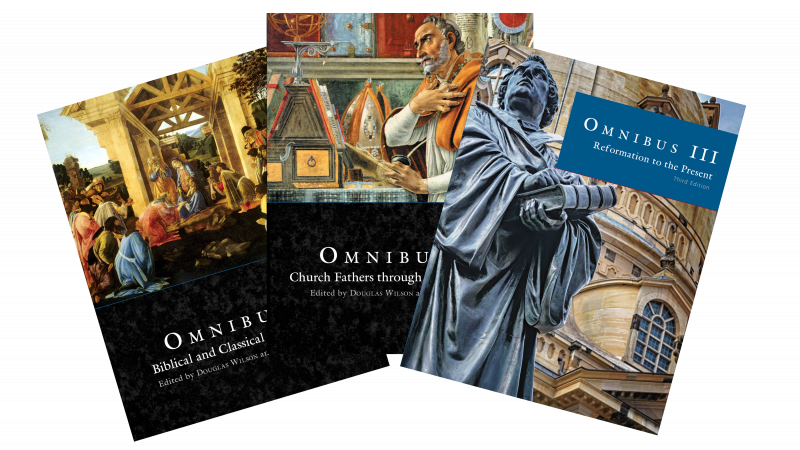3 Things to Consider When Sequencing Omnibus Reading

3 Things to Consider When Sequencing Omnibus Reading
People ask me, "How should I sequence the Omnibus," or, "Could I do Omnibus II before Omnibus I because I find it easier?"
In this post, I want to provide some good reasons or practices concerning sequencing and some bad reasons or bad practices concerning sequencing the Omnibus curriculum. Again, this is not a question of absolute right or wrong. It is a question of prudence—what is wise to do next.
First, there are three pre-considerations needed to answer this question prudently:
- How long are you going to be on the bus? If you are teaching Omnibus for the first time at your school or with your child, and you have a group of 11th graders or an 11th-grade son or daughter, I would encourage you to think about what two Omnibus years you want to cover. Don’t, please don’t try to cover six years of curriculum in two years. You might cause your child to hate the Great Books, reading, and school. Pick what works best for your child or class if your time is short.
- What is your child’s background or your class's average background? If they are strong readers, focus on more challenging books out of the box. If your child or the average reader in your class are not strong, focus on easier books or years initially. You can always build up from there. Start where you are, not where you want to be
- Deep or Wide: Are you after breadth or depth, and why do you want it? Consider whether you and your students value depth or breadth more. Of course, like the vacation Bible school song says we all want deep and wide, but initially you might have to choose to focus on one or the others. I would recommend depth, but if your child or class really needs more of a survey then width or speed might be a greater value. Think through what you value when you are planning your year of reading (and know that you might have to alter your plan as you go along because like all war plans are great until you face the enemy!).
With those three things in mind, here are three considerations for sequencing the Omnibus.
Consideration 1: Changing Sequence Because You Think a Different Year is Easier
I have been asked a lot about Omnibus I and II. I know that some people think that Omnibus II is easier. I don’t see it, and that hasn't been my experience at school. Ancient works might feel a little less accessible, but the medieval stuff in Omnibus II is not a cakewalk either.
Changing the sequence when you think something is easier, however, might be a positive move, but ask yourself: why are you changing the sequence? Be careful not to change it because you want to avoid hard stuff. If you consistently apply this principle, your child or students will never build the reading muscles that they need. That said, you must consider the student or students’ abilities. Always keep pushing, but don’t push more than your child can bear!
Consideration 2: Changing Sequence Because You Think a Different Year is More Accessible/Important
The Omnibus curriculum is made to get more challenging as time goes along. You can see this particularly when you look at the secondary books. We start in seventh grade with a lot of Narnia. The secondary books get tougher over time. The distance between them and the primary books is less in 12th grade than in 7th and 8th.
There might be years that you find more accessible. I think that Omnibus III and Omnibus VI can be viewed as more accessible because they are books that are come from modern times. Some of the books are more accessible because the experiences of the people in the book have more similarity than in the ancient or medieval years. (I do start each year with Milton’s Paradise Lost in Omnibus VI and I know that it is not the most accessible even though it is in the modern era.)
If you are going to make this change, please do the following: plan out multiple years—not just next year. This is a big deal. If you don’t, you are quickly going to have years that just don’t work. We had to do this when we were first implementing the Omnibus because we had such small numbers that we had combined classes. I had a seven-year spreadsheet showing what we were doing with each class for the next seven years. (I was so glad when we never had to look at this spreadsheet again!)
Consideration 3: Changing Sequence Because the Student Is Struggling with the Work
This is the toughest consideration and takes the most prudence. If you are a teacher, you might start reading something and find that it is rolling off your students’ minds like the proverbial water on ducks back. If you are a homeschooler, you have more freedom to make this change of sequencing. If you are a classroom teacher, please make sure that you are working with your school administrator on this. Still, make sure that you hear me on this mash-up of an Eastern proverb: if the student is not ready, it does not matter if the teacher appears. You have to work with the child or class that you have.
Consider this; however you might want to do the following (again, with your administrator’s approval): alter the list and pick the easiest books on the list to focus on. Use these easier books them like a gymnasium. Help the students build up muscles until they are ready to lift more weight. Don’t start by trying with 300 lbs. on the free weight bench press. Start easy and increase the difficulty. I would encourage you to look for the easier books with in the year you have decided to do instead of switching years. Instead of changing sequence, consider gearing down the speed and difficulty until the student is ready for harder work.
Again, sequencing is a question of prudence. There are rights and wrongs, but not universal ones. You have to take stock of your situation, make a plan, pray, and go into the battle. I pray that God sends His Spirit to lead and guide you as you consider these issues and sequence your year.
Omnibus Course Options:







